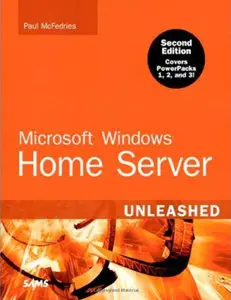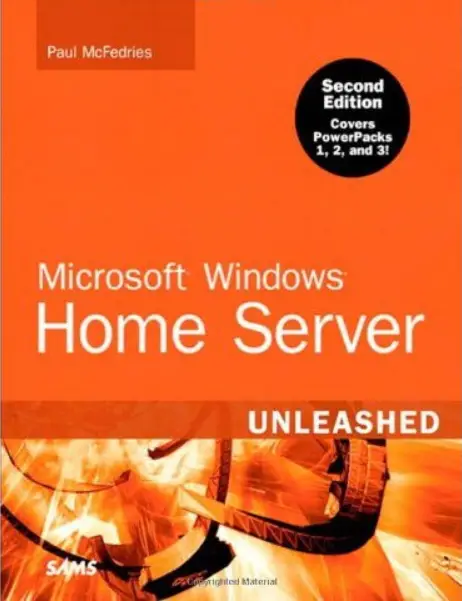Microsoft Windows Home Server Unleashed (2nd Edition) by Paul McFedries (Repost)
S__s | English | 2010 | ISBN: 0672331063 | 793 pages | PDF | 14.4 MB
Microsoft Windows Home Server Unleashed
Second Edition
Covers PowerPacks 1, 2, and 3!
Paul McFedries
This is the most comprehensive, practical, and useful guide to Windows Home Server, including Microsoft’s major updates in PowerPacks 1, 2, and 3. Top Windows expert Paul McFedries brings together tips, techniques, and shortcuts available nowhere else and presents them all in plain English for every Windows Home Server user.
McFedries covers all facets of running Windows Home Server: configuration, file/folder sharing, networking, media streaming and sharing, backup/restore, monitoring, Web and SharePoint site deployment, performance optimization, maintenance, and customization. He thoroughly addresses Windows Home Server’s new Windows 7 support, as well as major improvements in areas ranging from remote access to storing TV recordings.
This edition presents comprehensive, up-to-the-minute guidance on Windows Home Server security, plus a full section of advanced solutions utilizing Microsoft’s power tools, the command line, and automated scripting. Throughout, McFedries demonstrates key techniques through real-world examples and presents practical configurations you can easily use in your own home.
Detailed information on how to…
Set up Windows Home Server networks, user accounts, devices, and storage
Integrate with Windows 7’s new file libraries, backup/recovery tools, and Windows Search 4.0
Efficiently share folders, files, and digital media
Ensure security for both local and remote users
Automatically back up and restore all the computers on your home network
Quickly set up web and SharePoint sites
Tune, maintain, and troubleshoot Windows Home Server
Use the new Remote Access Configuration and Repair Wizards
Category: Windows Server
Covers: Windows Home Server with PowerPacks 1, 2, 3
User Level: Intermediate–Advanced
Introduction
When you think of the word server, you probably first imagine either a massive mainframe hulking behind locked doors in the bowels of some large corporation, or a powerful and very expensive desktop-like device full of esoteric hardware that helps it—and perhaps a few others like it—run the network of a medium-sized company. The common thread here is that we've always thought of servers as business machines. With the exception of a few hardcore geeks and technical writers (not that the two designations are mutually exclusive), having a server in your home seemed, well, excessive. What home needs the power of a server? What home can afford the expense of such a high-end device?
But then a funny thing happened: times changed. All those one-computer households suddenly became two-, three-, and even four-computer households; broadband became nearly ubiquitous, and of course every family member wanted a piece of the new pipe; we began digitizing our media en masse, and we wanted to share that media with other members of the family and with other devices scattered around the house; and we discovered wireless computing and became addicted to working and playing anywhere we wanted. The result has been an explosion of home networks over the past few years.
However, it didn't take long for amateur network administrators to learn something that their professional counterparts have known for many years: the larger the network, the more you need some device in the middle of it all to coordinate activities and offer a central repository for data. And our home networks have started to become quite large, with multiple computers, multiple devices such as wireless access points and network attached storage drives, and increasingly massive files, from multiple-megabyte digital audio files to multi-gigabyte digital video files. Suddenly we, too, needed a powerful machine in the middle of it all to keep things humming.
It helped significantly that extremely powerful computers had became extremely inexpensive, but one big problem remained: a server computer needs a server operating system. Unfortunately, the only choices here simply weren't reasonable or practical choices for the home: the powerful but expensive Windows Server 2003 or Windows Server 2003 Small Business Edition, or the various flavors of Linux, all of which are far too complex and arcane for the average home network.
However, the last piece of the puzzle fell into place when Microsoft announced Windows Home Server to the world in January 2007. Now we all had access to a server operating system that was designed specifically for home networks; we had access to a server OS that was easy to configure, simple to use, inexpensive, and could run on a variety of hardware; we had a server OS that not only did the usual server tasks—store data and manage users—but that also went much further with automatic backups for every computer, streaming media, and easy-to-configure access to any desktop from the network or from the Internet.
Welcome, then, to Microsoft Windows Home Server Unleashed. My goal in this book is to take you beyond the basic Windows Home Server Console interface and into the tremendously powerful behind-the-scenes features that enable you to get the most out of your investment without requiring an advanced networking degree.
Who Should Read This Book
For a book like this, it doesn't make much sense to have a "typical reader" in mind when writing. First, there's just no such thing as a typical reader, so you'd be writing for an audience of none. Second, home networks are as varied and unique as the families who use them. There are simple two-computer homes; there are large one-computer-per-person households; there are families who qualify as media powerhouses that create, share, and play audio and video incessantly; there's the home-office crowd who use their network for work as well as play; and finally there's Alpha Geek family with one person who's juiced not so much about Windows Home Server itself, but about getting his hands on the powerful Windows Server 2003 engine that comes with it.
In this book, I've tried to keep all these different families and situations in mind, and there's lots of content here for everyone. As a general rule, this book is for anyone who wants more from Windows Home Server. If you want to learn more about how Windows Home Server works, if you want to get more out of the unique features in Windows Home Server, and if you want to know how to use the powerful but hidden server features that are also part of the Windows Home Server package, this book is most definitely for you.
How This Book Is Organized
To help give you a sense of the overall structure of the book, the next few sections offer a brief summary of the six main parts of the book.
Part I: Unleashing Windows Home Server Setup
Part I takes the advice of the king in Alice in Wonderland: "Begin at the beginning." You get a bird's-eye view that describes what Windows Home Server is and what you can do with it (Chapter 1); you learn how to install Windows Home Server, just in case it didn't come preinstalled for you (Chapter 2); and you learn how to set up Windows Home Server for networking and how to troubleshoot basic network woes (Chapter 3).
Part II: Unleashing Windows Home Server Configuration
The four chapters in Part II show you how to get everything configured and connected so that you can start to take full advantage of what Windows Home Server has to offer. You learn how to set up and manage user accounts (Chapter 4); I show you how to add various computer types—Windows Vista, XP, and 98, as well as Mac and Linux—and various devices—including Windows Mobile and Xbox 360—to the Windows Home Server network (Chapter 5); you learn how to configure various Windows Home Server settings, including the computer name, the password, and various startup options (Chapter 6); and I delve deep into the new Windows Home Server storage system to show you how the system works, how to add, repair, and remove storage, and more (Chapter 7).
Part III: Unleashing Windows Home Server Networking
Part III is the biggest section of the book, with eight chapters focused on various aspects of networking with Windows Home Server. You learn how to share files and folders (Chapter 8); connect to other computers, both over the network and over the Internet (Chapter 9); stream and share digital image, audio, and video (Chapter 10); use Windows Home Server's computer backup and restore features (Chapter 11); monitor your network (Chapter 12); and implement network security (Chapter 13). I close this section with two chapters that take you well beyond Windows Home Server's core capabilities: Chapter 14 shows you how to use the built-in web server to create powerful and flexible websites, and Chapter 15 shows you how to download, install, configure, and use Windows SharePoint Services to run collaborative sites for your family.
Part IV: Unleashing Windows Home Server Performance and Maintenance
Part IV takes you into some of the features of Windows Home Server that are less glamorous but are still crucially important: performance tuning (Chapter 16), system maintenance (Chapter 17), interface customization (Chapter 18), and problem troubleshooting (Chapter 19).
Part V: Unleashing Windows Home Server Advanced Tools
The four chapters in Part V take your Windows Home Server knowledge to a higher level with in-depth looks at some advanced tools and features. You learn how to use the Windows Home Server Registry (Chapter 20); how to use the command-line tools (Chapter 21); how to use power tools such as the Control Panel, the Group Policy Editor, and the Computer Management snap-ins (Chapter 22); and how to create Windows Home Server scripts, including scripts that control the incredibly powerful Windows Management Instrumentation (WMI) interface (Chapter 23).





